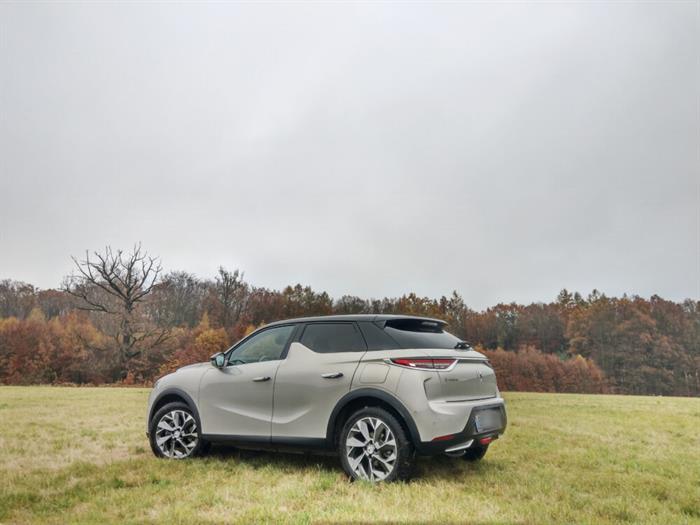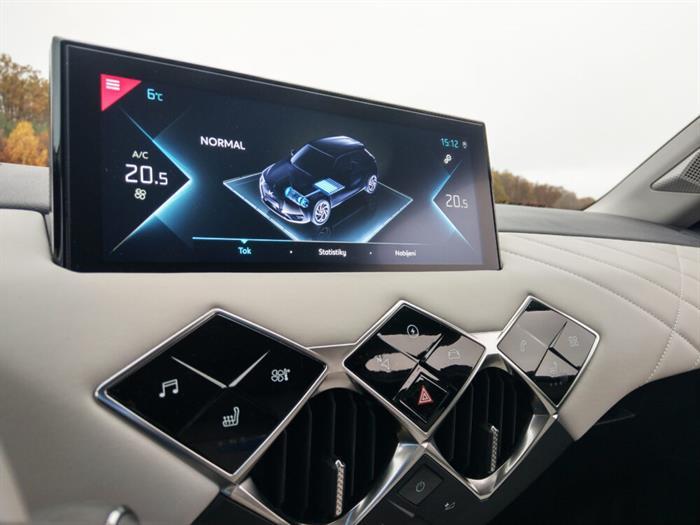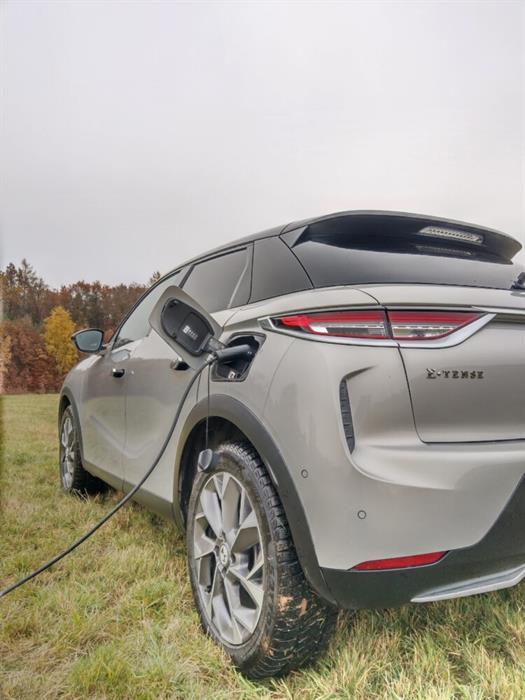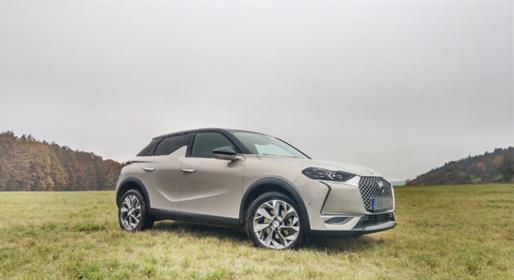The DS 3 Crossback model is the second venture of the DS car company, which has been presenting itself as an independent entity since 2014, offering its customers cars of premium quality and imaginative design. The DS 3 is the smaller of the pair of siblings, both faithfully adhering to the ideas of the SUV category.
However, we currently tested the DS 3 model with an electric drivetrain, i.e. the E-Tense variant. This original compact SUV has recently received a quite powerful electric motor and a very decent range. So what is it like, the first fully electric car from the DS car company?

The electric design did not take anything away from the car's imaginative exterior
The basic shapes of the DS 3 Crossback are fully based on belonging to the category from which this car is based. Its rather shorter and elevated proportions with a higher body structure clearly belong to the compact SUV category.
In terms of exterior design, the DS 3 is a very imaginative and playful car, similar to its larger sibling, the DS 7 . The car will thus offer several recognition signs that will easily identify it. One of them is, for example, a kind of fin that the side doors have, and which refers to the previous DS 3 model. We also have the daytime running lights, which the DS 3 shared from the larger DS 7, so the car has a very typical lighting signature. And last but not least, we have the door handles, which are integrated into the body of the car most of the time. They then go out automatically when the car is unlocked, which, similarly to the locking itself, takes place completely automatically when you come into close contact with the car.
The interesting visual connection, the common handwriting, of the currently offered models (DS 3 and DS 7) is most evident from the rear part. The latter in both cars has very narrow horizontally oriented lamps, which are lined and at the same time connected by very rich chrome plating. I already mentioned the front daytime running lights and their light signature.
Belonging to the electric drive system, the DS 3 is revealed only by the inscription on the trunk lid and the plaque on the front hood. The absence of exhaust tips is alternated in the rear bumper by a pair of very decent curved lines.

Interior, still interlaced with a rhombus
Even after electrification, the main motif of the interior of the DS 3 is still the rhombus motif, which is clearly defined within the dashboard in the individual controls, air conditioning vents or in the patterns created by the stitching of the dashboard or side panels of the doors.
The dashboard of the DS 3 is still very playful and quite imaginative. Its central motif is the relatively large on-board infotainment display, which offers a familiar and intuitive environment. Below the aforementioned display, the dashboard is equipped with controls, to which a button for calling up the electric drive assistant has been newly added as part of the E-Tense electric version. This is of course displayed within the on-board infotainment display .

To my taste, the rather smaller display of the instrument cluster in front of the driver will offer more display modes, which are traditionally interwoven with a diamond motif in this car.
An original and rarely seen element are the side vents of the air conditioning, which are completely integrated into the side panels of the doors, not into the dashboard itself.
A massive central tunnel, which, following the example of its larger sibling, will offer, in addition to the automatic gearbox selector, also a rather unconventionally located control for the electric lowering of all windows. There is also a slightly modified gearbox selector, which in the case of the tested electric version will additionally offer a position ("B") of the recuperative brake.
The interior space is oriented more towards the front crew, where you will find spacious and comfortable seats. The DS 3 does not offer much space in the rear seats and in the trunk. In addition, the rear positions are optically narrowed by the relatively massive backrests of the front seats, and the design "fin" also greatly affects the size of the rear door glazing. The luggage compartment itself will then offer a volume of 350 l.
The DS 3, even in the E-Tense electric version, offers an original interior that is well finished and the exterior completes a very compact whole.

Electric propulsion system
The electric DS 3 is equipped with an electric motor that drives the front axle and offers exactly 100 kW of power, with a torque of 260 Nm. The electrical energy is then stored in a battery with a volume of 220 l and a capacity of 50 kWh (usable approx. 45 kWh), which is very cleverly distributed over the floor of the car, without any overlap in the size of the car's cabin or in the luggage compartment.
The tested E-Tense is mainly an urban electric car with a performance that is more than adequate for this environment. So don't expect any "kicks" when you step on the gas sharply, but a smooth influx of power and continuous acceleration of the car. The car then manages 100 km/h in 9 seconds and the maximum speed is limited to 150 km/h, so even on the highway it will not limit your performance in any way.
And while we're talking about those "limitations", let's take a look at the car's range itself, because even here the electric "three" is doing very well. According to WLTP, the indicated range is a very respectable 320 km. And yes, this value is highly variable, as it simply depends on many different parameters, from the current weather, the driving profile to, for example, your driving style.
I currently tested the car in rather dry and cold weather, so the heating of the car was on for a considerable amount of time, as was the heating of the seats. In this weather, I drove the electric DS 3 during the weekly test with a consumption of around 18 kWh/100 km, which corresponds to a range of around 250 km. However, the long-term consumption of the on-board computer showed a value of 16.6 kWh/100 km, which seems to me to be a very realistic figure allowing for a range of up to 270 km, given that the weather is on average better than the current one. Here, the DS 3 E-Tense definitely deserves praise, because the radius that this range allows you is already very decent.

Charging the car itself then proceeds as follows, according to the seller's information, it takes about 5 hours to charge for a range of about 50 km from an ordinary home socket (a full charge then takes more than 24 hours), via the Wallbox using three-phase current (11 kW) you can fully charge the car in 5 hours and 15 minutes, from the classic Wallbox in the case of single-phase current (7.4 kW), the car is charged in 8 hours.
The car is also equipped with temperature regulation of the battery, which enables rapid charging of up to 100 kW, charging to 80% will take around 30 minutes at such a rapid charging station. Our most widespread 50 kW charging station will then delay you for approx. 1 hour.
So we have to praise the DS 3 Crossback E-Tense not only for its decent range, but also for its very good charging parameters.
In terms of driving impressions, the car offers the classic positives of an electric car, i.e. a comfortable and quiet ride, which in the "déesque" is additionally supported by a user-friendly and high-quality interior.
A trio of driving modes is also available. The classic NORMAL mode is complemented by the SPORT and ECO modes. In sports mode, the car will offer more power, faster response to the gas pedal, or stiffer steering. ECO mode is the complete opposite, the car is noticeably more tepid when you press the gas pedal, is less powerful and even affects the air conditioning itself.
In addition to the very decent range, fast recharging, and the comfort in the cabin, we also add a certain dexterity and agility in city traffic. The DS 3 Crossback E-Tense is therefore a very capable and not only urban electric car in terms of driving experience.

In conclusion
While thebasic DS 3 Crossback with petrol engine and six-speed manual costs 560,000 CZK including VAT, the electric DS 3 Crossback E-Tense starts at 995,000 CZK including VAT. This is the higher equipment level PERFORMANCE LINE, the highest equipment GRAND CHIC with electric drive can be purchased from CZK 1,075,000 including tax.
In addition, DS cars already include a 5-year / 60,000 km warranty in their purchase price, as well as a FreeDrive service contract included in this price, which includes all mandatory service, including service work and also the replacement of worn parts such as brake pads or a squeegee.
DS 3 Crossback is a compact SUV that simply does not lack a large dose of imagination and considerable flair. Its electric variant E-Tense gives it another dimension, which is very adequate for it. Because a certain stamp of exclusivity, which DS cars have, goes very well with the electric drive system.
Source: Author's text
Image source: Author's own photos




























